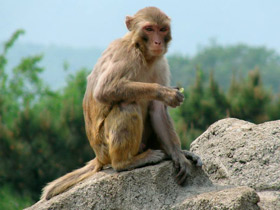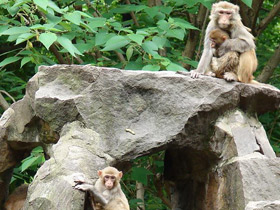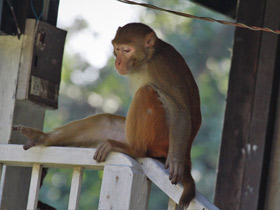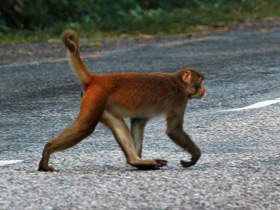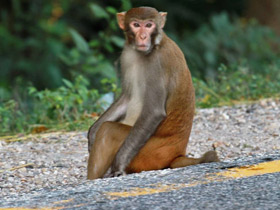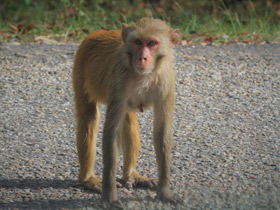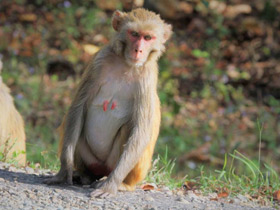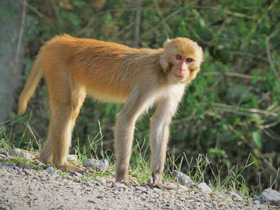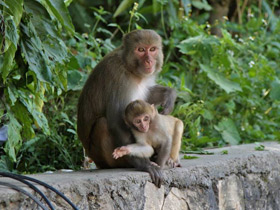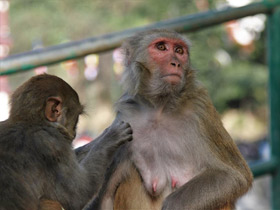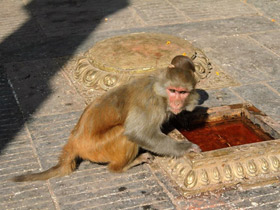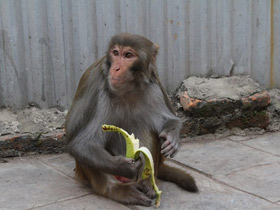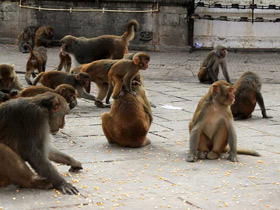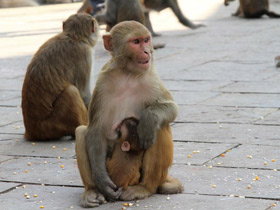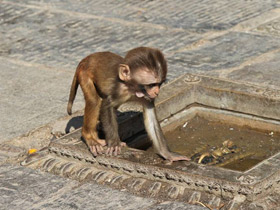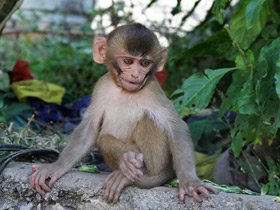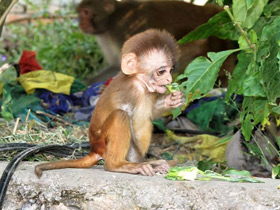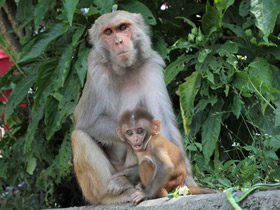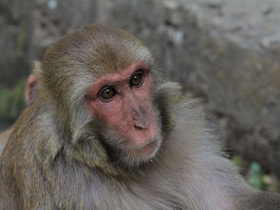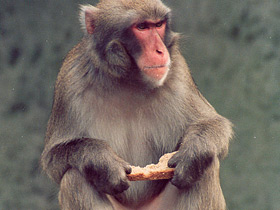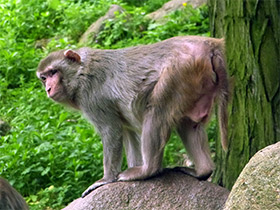The rhesus macaque (Macaca mulatta), rhesus monkey
The rhesus macaque (Macaca mulatta), colloquially rhesus monkey, is a species of Old World monkey. There are between six and nine recognised subspecies that are split between two groups, the Chinese-derived and the Indian-derived.
Appearance
The rhesus macaque (Macaca mulatta), often referred to as the rhesus monkey, is a species of catarrhine primate in the family Cercopithecidae, one of the best known of the Old World monkeys.
Macaca mulatta are quite large and dense monkeys: male body length varies from 45.5 to 63.5 cm, female body length from 37 to 58 cm, male body weight from 6 to 14.4 kg and female body weight from 3 to 10.7 kg. The fur of Macaca mulatta is dull greenish-yellowish; the face, ears and hands are pale flesh-coloured; the back of the body is brighter (with a reddish-orange tinge) than the front; the tail is covered with short, short hairs.
Distribution
Macaca mulatta is the most prosperous and widespread primate species in the world, its range and numbers are very high, found in Pakistan, India, in the Himalayas from Nepal to northern Burma, in southern China, Indochina. In India and Nepal, due to the patronage they receive from the Hindu religious populations, Macaca mulatta also inhabit the cultural landscape, including large cities. Indians consider them sacred animals and sometimes leave some crops from their fields unharvested for them.
Lifestyle and nutrition
Macaca mulatta live in herds of 20-200 individuals in forests or on open mountain slopes. They are not afraid of water and are good swimmers and divers. The clans, formed by family groups, are led by a single male and the whole herd may be led by one or several leaders.
Like most macaque species, Macaca mulatta are semi-urban and semi-terrestrial.
These omnivorous primates forage for a variety of prey in trees and on the ground. They can sometimes be quite aggressive. A group of Macaca mulatta has been observed to noisily chase away a Himalayan bear or a goose bear from a fruit tree.
Reproduction
Pregnancy in the Macaca mulatta lasts 164 days, and a calf is born, which the mother feeds for up to a year. The female Macaca mulatta reaches sexual maturity at 2.5-3 years, the male at 4 years.
Particularities
At a primatology centre in the Caribbean, where the monkeys live on islands and are kept in free-ranging conditions, it has been shown that the 25-year-old female, who gave birth for the last time at 17 and is now old, decrepit, suffering from arthritis and almost losing her sight, was treated with touching reverence by a group of young monkeys. They turned out to be relatives. When the female has been left behind on her travels, an adult grandchild or great-grandchild has always waited for her and then followed with her.
The public should be grateful to Macaca mulatta, as it was used for more than 40% of all ape research worldwide in physiology, more than half of all vision studies and more than 50% of all radiobiological experiments.
Thanks to experiments on these monkeys, the Rh factor, a blood compatibility factor, was discovered.
We owe it to them that our children do not suffer from polio, that the terrible epidemics of yellow fever have disappeared and that malaria and tuberculosis can be combated.
The Macaca mulatta is kept in many vivaria as a model object for medical, ethological and neurobiological research.
Taxonomy
According to Zimmermann's first description of 1780, the rhesus macaque is distributed in eastern Afghanistan, Bangladesh, Bhutan, as far east as the Brahmaputra Valley, Barak valley and in peninsular India, Nepal, and northern Pakistan. Today, this is known as the Indian rhesus macaque M. m. mulatta, which includes the morphologically similar M. rhesus villosus, described by True in 1894, from Kashmir, and M. m. mcmahoni, described by Pocock in 1932 from Kootai, Pakistan. Several Chinese subspecies of rhesus macaques were described between 1867 and 1917. The molecular differences identified among populations, however, are alone not consistent enough to conclusively define any subspecies.
The Chinese subspecies can be divided as follows:
- Macaca mulatta mulatta is found in western and central China, in the south of Yunnan, and southwest of Guangxi;
- Macaca mulatta lasiota (Gray, 1868), the west Chinese rhesus macaque, is distributed in the west of Sichuan, northwest of Yunnan, and southeast of Qinghai; it is possibly synonymous with Macaca mulatta sanctijohannis (R. Swinhoe, 1867), if not with Macaca mulatta mulatta.
- Macaca mulatta tcheliensis (Milne-Edwards, 1870), the north Chinese rhesus macaque, lives in the north of Henan, south of Shanxi, and near Beijing. Some consider it as the most endangered subspecies. Others consider it possibly synonymous with Macaca mulatta sanctijohannis, if not with Macaca mulatta mulatta.
- Macaca mulatta vestita (Milne-Edwards, 1892), the Tibetan rhesus macaque, lives in the southeast of Tibet, northwest of Yunnan (Deqing), and perhaps including Yushu; it is possibly synonymous with Macaca mulatta sanctijohannis, if not with Macaca mulatta mulatta.
- Macaca mulatta littoralis (Elliot, 1909), the south Chinese rhesus macaque, lives in Fujian, Zhejiang, Anhui, Jiangxi, Hunan, Hubei, Guizhou, northwest of Guangdong, north of Guangxi, northeast of Yunnan, east of Sichuan, and south of Shaanxi; it is possibly synonymous with Macaca mulatta sanctijohannis, if not with Macaca mulatta mulatta.
- Macaca mulatta brevicaudus, also referred to as Pithecus brevicaudus (Elliot, 1913), lives on the Hainan Island and Wanshan Islands in Guangdong, and the islands near Hong Kong; it may be synonymous with Macaca mulatta mulatta.
- Macaca mulatta siamica (Kloss, 1917), the Indochinese rhesus macaque, is distributed in Myanmar, in the north of Thailand and Vietnam, in Laos, and in the Chinese provinces of Anhui, northwest Guangxi, Guizhou, Hubei, Hunan, central and eastern Sichuan, and western and south-central Yunnan; possibly synonymous with Macaca mulatta sanctijohannis, if not with Macaca mulatta mulatta.
Conservation status
The rhesus macaque is listed as Least Concern on the IUCN Red List and estimated to exist in large numbers; it is tolerant of a broad range of habitats, including urban environments. It has the largest natural range of any non-human primate. The Thai population is locally threatened. In addition to habitat destruction and agricultural encroachment, pet releases of the different species into existing troops are diluting the gene pool and putting its genetic integrity at risk. Despite the wealth of information on its ecology and behaviour, little attention has been paid to its demography or population status, which can pose a risk for future Rhesus macaque populations. The extension of its distributional limits by approximately 3,500 km2 (1,400 sq mi) in southeast India caused population stress on other species. This range extension has been caused by human intervention tactics whereby village translocation occurs from urban conflict ridden areas.

















